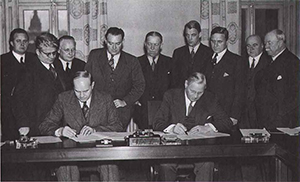Corporatism and the Nordic countries
Corporatism is about the influence of organisations and interest groups on policy making. The Nordic countries are societies with strong interest groups, acknowledged and privileged by the state, that wield considerable influence on policy making and implementation. Corporatism, or neo-corporatism, is found within industrial relations, but is also relevant in areas like agriculture, traffic, environment, and many others. In the Nordic countries, a number of alternative terms (e.g. ‘negotiating economy’, ‘mixed economy’, or ‘mixed administration’) have frequently been used to describe the same phenomena.

Notwithstanding the notion of pervasive government in the Nordic region, there is a characteristic tendency towards a two-partite corporatism involving trade unions and employer organisations. Nordic governments have been hesitant to take action in fields where self-regulation of corporate actors seems possible, particularly with structures that allow for centralised decision-making that reflect the general interest. As noted by the Finnish scholar Kettunen in his 1997 article ‘The Society of Virtuous Circles’, collective agreements are:
“regarded as a higher, more desirable form of regulation than the direct state intervention through legislation.”
This is especially so in the field of industrial relations.
While interest groups maintain a high degree of autonomy, Nordic governments try to have some influence over the relevant organisations, e.g. in regard to economically desirable wage increases. Laws affecting major interest organisations often settle for providing the framework for more specific self-regulation, e.g. in the field of workplace co-determination. At the shop floor-level in Denmark and Norway, this field is left to collective agreements between labour market partners. In Sweden and Finland, framework laws introduced in the 1970s only stipulated the duty to negotiate on these issues.
Corporatism in practice
A culture of corporatism has been reflected in not only the make-up and conventions around parliamentary commissions and committees, but also the type of tripartite negotiations that form much of national policy. The historically strong labour movement and culture of consensus have allowed for few industrial conflicts, which has in turn permitted large sections of industrial relations to remain outside the realm of direct state interference. Parliamentary commissions, which used to prepare most politically relevant decisions, have been an important channel for corporate actors to influence national policy, especially in Sweden, but also in Finland and Norway. This mainly applies to:
- the more or less formalised referral of policy proposals to different organisations for their comment;
- direct representation in the commissions; and,
- participation in policy-making from the outset.
Members of major organisations, trade unions in particular, have also played a significant role in parliamentary committees. As for policy implementation, there has been a pronounced tendency in the Nordic region to equip state administration with organisational know-how and control. This has been achieved through honorary executive committees, as well as different kinds of lay boards and advisory councils. Implementing corporatism as such developed dynamically during the two world wars. In some areas, the process went so far as to completely transfer administration tasks to certain organisations, e.g. the allocation of state subsidies or regulations within the primary sectors of the economy.
Recent de-corporatisation
The notion of de-corporatisation present in social science analysis since the 1990s might be overstated. Some observers have jumped to the conclusion that corporatism is obsolete, but such a claim exaggerates political dynamics while at the same time presupposes a static understanding of the concept of corporatism. Nevertheless, the integration of established interests in the formulation and implementation of different policies is in decline in the Nordic countries. This phenomenon is primarily caused by a decrease in formal representation in policy-preparation processes which is somewhat compensated for by increasing informal contacts, not least with members of parliament. In this context, the privileged position of particular organisations such as trade unions is declining, while the opportunities for a plurality of civil society associations and new interests to make themselves heard increases. Moreover, the tendency toward de-corporatisation is stronger on the national level than in local decision-making processes.
The heyday of corporatism in the Nordic region lasted from the 1930s to the 1970s, a period of overall high rates of economic and public sector growth. While there is an affinity of corporatism and distributive policy agendas, the phenomenon is not limited to this period. Despite currently more constrained political agendas and the observation of tendencies sometimes designated as de-corporatisation, a study on the strength of corporatist arrangements in 36 countries in 1999 ranked Norway and Sweden first and second, respectively; Denmark was placed fourth and Finland tenth (see reference by Lijphart). There is no indication that this picture has fundamentally changed in the present century. Corporatism also tends to be path-dependent and self-sustaining as it has become an integral part of Nordic political cultures and styles.

The Saltsjöbaden agreement, signed in Saltsjöbaden in Sweden in 1938, was the most famous of its kind and the so-called ‘spirit of Saltsjöbaden’ represented a symbolic core of the Nordic political model from then on. Centralised wage-setting involving both employers and employees still occurs in the Nordic countries, despite growing de-corporatism. Photo: Wikimedia Commons
History of corporatism
It is believed that the first scholar to systematically apply the term ‘corporatism’ to democratic societies was a Swede, the political scientist Gunnar Heckscher, in 1946. Around 1930 the Nordic labour movements appeared strong enough to make them attractive partners for capital. In the years between 1935 and 1944, employers’ federations and trade union federations (generally known as Landsorganisationen or similar (LO)) concluded central agreements regulating procedures for addressing possible industrial conflicts in Norway, Sweden and Finland. A first settlement of this kind had already been reached in Denmark in 1899. Because of these historical compromises and the emerging culture of consensus, the level of industrial conflicts was reduced to a minimum and large sections of industrial relations usually remained outside the realm of direct state interference. As the Swedish welfare state had been based on a specific model of industrial relations with a solidaristic wage policy at its centre, the Saltsjöbaden agreement of 1938 became the most famous of its kind. The so-called ‘spirit of Saltsjöbaden’ represented a symbolic core of the Nordic political model until the Swedish Employers’ Confederation (Svenska Arbetsgivareföreningen (SAF)), following the Danish example, withdrew from centralised wage-setting with its labour counterpart in the mid-1980s. In Finland, the establishment of stable corporatist structures on the labour market did not succeed before the end of the 1960s.
Further reading:
- N. Götz, ‘Century of Corporatism or Century of Civil Society? The Northern European Experience’, in N. Götz and J. Hackmann, eds., Civil society in the Baltic Sea region (Aldershot: Ashgate, 2003).
- P. Kettunen, (1997) ‘The Society of Virtuous Circles’, in P. Kettunen and H. Eskola, eds., Models, Modernity and the Myrdals (Helsinki: University, 1997).
- P.M. Christiansen, ‘Still the Corporatist Darlings?’, in P. Nedergaard and A. Wivel eds., The Routledge Handbook of Scandinavian Politics (London: Routledge, 36–48, 2018). pp. 36-48